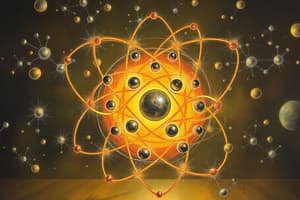Podcast
Questions and Answers
What is the chemical symbol for Hydrogen?
What is the chemical symbol for Hydrogen?
- H (correct)
- Li
- O
- He
What is the atomic number of Helium?
What is the atomic number of Helium?
- 1
- 4
- 2 (correct)
- 3
Which element has the chemical symbol Li?
Which element has the chemical symbol Li?
- Lithium (correct)
- Carbon
- Boron
- Beryllium
What is the atomic number of Beryllium?
What is the atomic number of Beryllium?
Which element is represented by the symbol B?
Which element is represented by the symbol B?
What is the chemical symbol for Nitrogen?
What is the chemical symbol for Nitrogen?
Carbon has which atomic number?
Carbon has which atomic number?
What is the chemical symbol for Oxygen?
What is the chemical symbol for Oxygen?
What is the atomic number of Fluorine?
What is the atomic number of Fluorine?
What is the atomic number of Neon?
What is the atomic number of Neon?
What is the chemical symbol for Sodium?
What is the chemical symbol for Sodium?
What is the atomic number of Magnesium?
What is the atomic number of Magnesium?
What is the chemical symbol for Aluminum?
What is the chemical symbol for Aluminum?
What is the atomic number of Silicon?
What is the atomic number of Silicon?
What is the chemical symbol for Phosphorus?
What is the chemical symbol for Phosphorus?
What is the atomic number of Sulfur?
What is the atomic number of Sulfur?
What is the chemical symbol for Chlorine?
What is the chemical symbol for Chlorine?
What is the atomic number of Argon?
What is the atomic number of Argon?
What is the chemical symbol for Calcium?
What is the chemical symbol for Calcium?
What is the atomic number of Potassium?
What is the atomic number of Potassium?
Study Notes
Overview of the First 20 Elements
- The periodic table begins with Hydrogen, the lightest element with atomic number 1 and symbol H.
- Each element has a unique atomic number, which defines its position on the table and its identity.
Grouping of Elements
- Elements are divided into periods based on their atomic structure.
- Elements 1 to 10 are in the first two periods, while elements 11 to 20 span three periods.
Key Elements and Their Properties
- Hydrogen (H): Atomic number 1; lightest and most abundant element in the universe.
- Helium (He): Atomic number 2; a noble gas known for its non-reactivity.
- Lithium (Li): Atomic number 3; a light metal used in batteries.
- Beryllium (Be): Atomic number 4; a strong but toxic metal used in certain alloys.
- Boron (B): Atomic number 5; important in glass and ceramics production.
- Carbon (C): Atomic number 6; foundational to organic chemistry, known for its versatility in forming complex molecules.
- Nitrogen (N): Atomic number 7; makes up 78% of the Earth’s atmosphere; essential for life.
- Oxygen (O): Atomic number 8; critical for respiration and combustion.
- Fluorine (F): Atomic number 9; highly reactive and found in toothpaste and Teflon.
- Neon (Ne): Atomic number 10; a noble gas commonly used in signs.
Transition to New Periods
- Sodium (Na): Atomic number 11; a highly reactive metal, commonly found in table salt.
- Magnesium (Mg): Atomic number 12; essential for many biological processes and used in alloys.
- Aluminum (Al): Atomic number 13; lightweight and corrosion-resistant, widely used in packaging and construction.
- Silicon (Si): Atomic number 14; a key component in electronics and semiconductors.
- Phosphorus (P): Atomic number 15; important for DNA, ATP, and fertilizers.
- Sulfur (S): Atomic number 16; used in fertilizers and pharmaceuticals.
- Chlorine (Cl): Atomic number 17; widely used as a disinfectant and in the production of plastics.
- Argon (Ar): Atomic number 18; a noble gas, often used in lighting and welding.
- Calcium (Ca): Atomic number 19; crucial for bones and teeth, used in construction.
- Potassium (K): Atomic number 20; vital for plant growth and a key electrolyte in the human body.
Studying That Suits You
Use AI to generate personalized quizzes and flashcards to suit your learning preferences.
Description
This quiz covers the introduction to the first 20 elements of the periodic table, focusing on their atomic numbers, properties, and classifications. Explore how these elements are grouped into periods and learn about their unique characteristics and applications. Ideal for students studying chemistry fundamentals.




